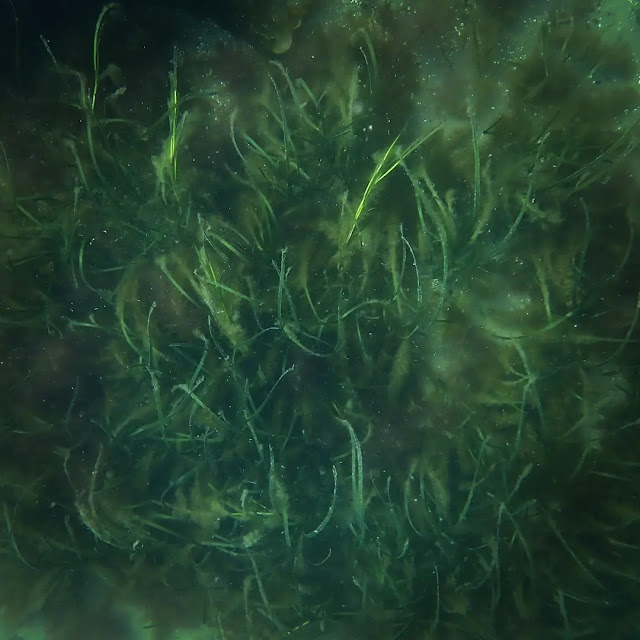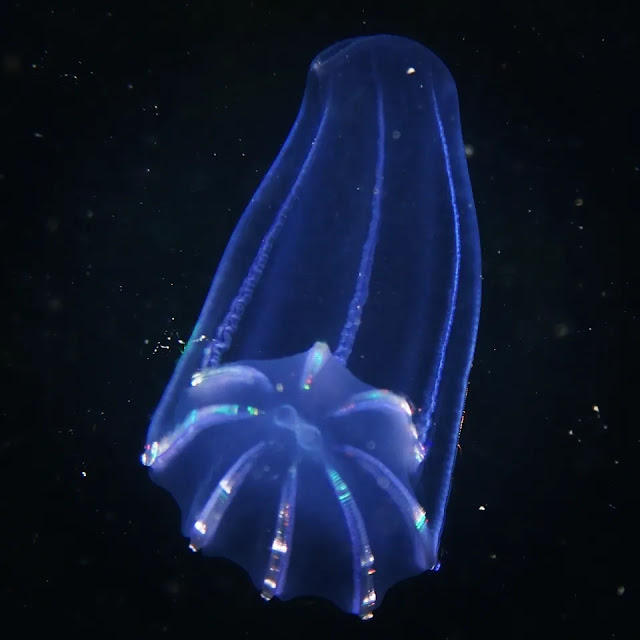Bull Hole, for those who don’t know it, is the largest
colony of razorbills and guillemots on Skomer – a seething vertical seabird
city that emanates waves of croaky cries and guano aromas – and counting the
auks there was my very first task as Seabird Monitoring Volunteer.
With my unpacked bags and food for a month stacked at the
farm, Ceris gave me a whistle-stop tour of auk counting as the daily 4pm
deadline crept closer. She subdivided the cliff into sections and talked me
through the boundaries with chat along the lines of “you see the crack in the
cliff face that looks like a lightning bolt”. Once we were sure we were looking
at the same area and were counting the same species, we were off with
binoculars raised and thumbs poised at our clickers.
 |
| Click for every guillemot you see... © Becci Jewell |
 |
| Guillemot © Becci Jewell |
Next followed a period of eye-wateringly intense
concentration as I stared at the mass of auks huddled on the ledges, heads
bobbing and squabbles erupting. Were the birds standing three or four deep on
that bit in the shade? Had I already counted the group on the ledge above, and
were the birds on the lower ledge breeding there or just loafing? Now where had
I got to on the main ledge? Finally, when I was as confident as I could be that
I’d counted each and every individual and, crucially, had counted them only
once, came the scary moment of revealing my final tally. Within 10% of Ceris’
count and all was well. Outside 10% of Ceris’ count and we were back to the
beginning, counting again. This mix of beautiful setting, breath-taking
wildlife and intense concentration tinged with fear set the scene fantastically
for my month of seabird monitoring on Skomer.
Some of the seabird colonies can only be counted from the
sea and if I thought counting seabirds from land was hard (which I did and
still do), counting them from a boat was a whole new level of difficult. Even
on fair-weather days, strong tides scour the island creating waves, swirls and
eddies that jostle and spin the boat. Craning our necks up at the cliffs,
keeping track of where we were counting just got much, much harder. Slowly but surely,
we got there though, helped by a run of excellently timed good weather. As my
dodgy tan lines and knowledge of ABBA lyrics grew, the list of sections left to
count shrunk until, finally, the auk counts were done for another year.
 |
| Kelda, Eve & Becci |
As the good weather came to a rainy and blustery end, we
started the Manx shearwater counts at the first of 18 plots around the island.
There are approximately 700,000 Manx shearwaters on Skomer between March and September
yet it’s entirely possible to visit the island without seeing any of these
nocturnal birds. Breeding pairs lay a single egg usually in May, from which
point one of the pair remains in the burrow to incubate it whilst the other
bird forages in the productive waters of the Irish Sea.
 |
| Manx shearwater at sea © Becci Jewell |
Manx shearwaters produce a garbled and quite spooky call,
usually at night, but can also be tricked into calling during the day by the
sound of another Manx shearwater. So, at each of the 18 plots, we gently
crawled around on fragile burrowed ground, poking a small speaker into the
entrance of every burrow and noting whether the recording prompted a reply from
the bird on egg incubating duty. Going burrow to burrow, we crawled through
dense bracken, tussled with stinging nettles and bum-shuffled down steep
clifftop slopes in bright sunshine, pouring rain and everything in-between, clutching our speakers and clickers. Regular biscuit breaks were instrumental
in maintaining morale and focus, particularly on the days when incessant rain
crept into our hoods and seeped up our sleeves.
When the weather allowed, we switched to counting kittiwakes and fulmars around the island, again some from land and some from the
boat. Instead of counting individuals (as we did for razorbills and
guillemots), we counted nests (for the kittiwakes) and sites (for the fulmars). These counts were an epic whole-island effort as
we set off in different directions to cover all sections of the island, ticking
them off as the end of the four-week seabird counting window approached.
Brilliant teamwork saw the kittiwake and fulmar counts done with a few days to
spare and our efforts returned to the final four Manx shearwater plots which
were finally completed by a tired team running on tea, cake and determination.
With faces caked in wind-blasted soil, we checked the last burrows before handing
in our clickers and gingerly tiptoeing back to more solid ground.
 |
| The last Manxie plot © Becci Jewell |
 |
| A grubby but happy team! |
The days were long, the weather unrelenting and the birds
not always cooperative. Plus, I often couldn’t quite make out the crack in the
cliff that looked like a lightning bolt. I’d not swap a day of it though,
working with a great team of people on an island teeming with life. As well as
learning how the seabird counts are carried out, I was lucky enough to join
some of the researchers on the island and assist with the weighing of chicks
and the ringing of adults, learning more about the seabirds that depend on
Skomer and the surrounding seas. I’m extremely grateful for all the knowledge
shared and memories accumulated. From the seabirds that fill the burrows and transform
the cliffs, to the harbour porpoise that sweep by with the tide and the glow worms
that illuminate the bracken, Skomer is a truly special place.
 |
| Becci with razorbill chick |
 |
| Glow worm © Becci Jewell |
 |
| Sunrise from the Farm © Becci Jewell |





















